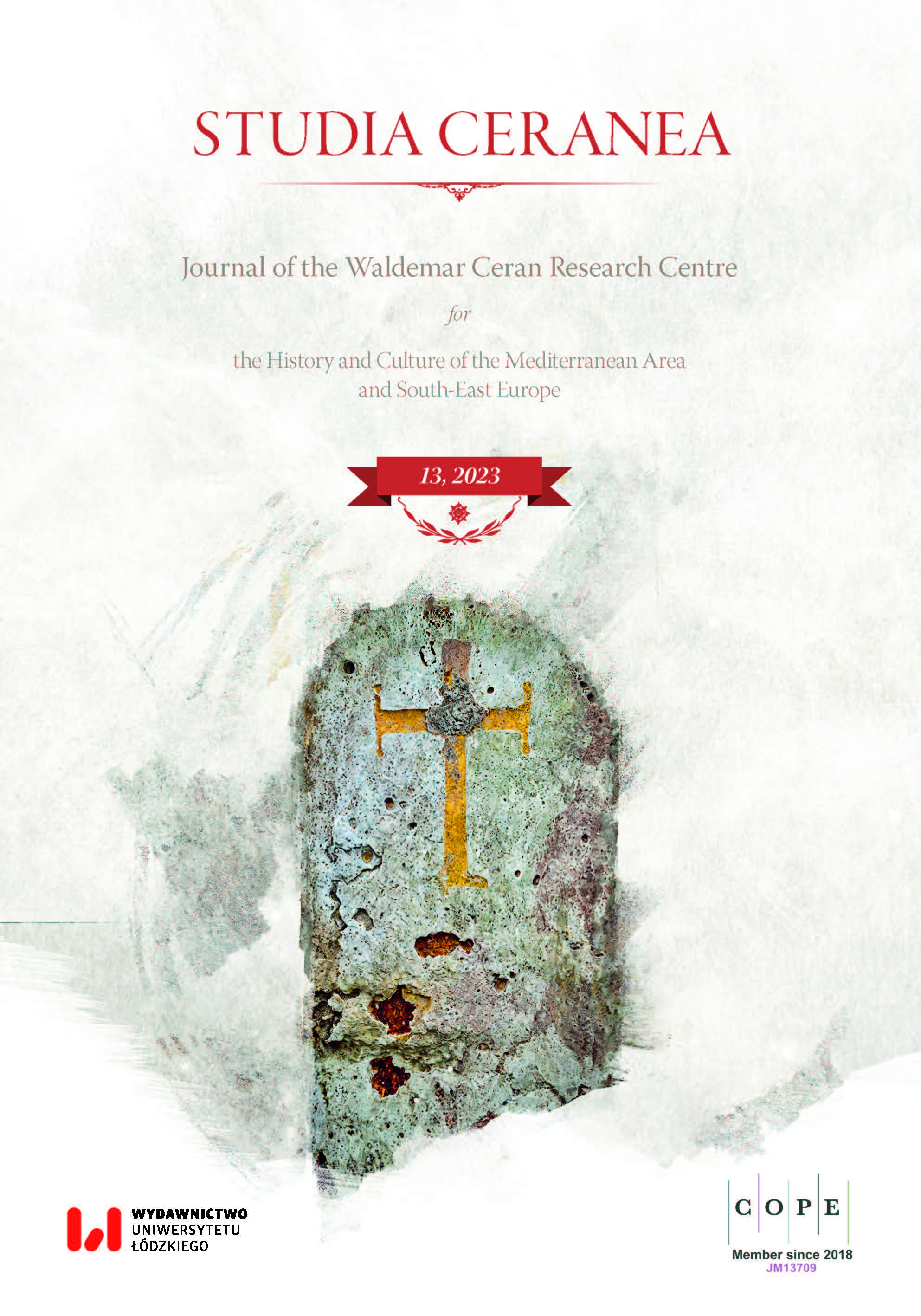Representing the Phlegm: the Portrait of the Phlegmatic in Cesare Ripa’s Iconology
DOI:
https://doi.org/10.18778/2084-140X.13.01Keywords:
Cesare Ripa, Iconologia, humoral theory, humors, phlegmatic, iconographic attributesAbstract
This article is the second in a series of works which aims to contribute to documenting the success of the medical theory of individual complexions, derived from the theory of the four humours, through the major work which constitutes the Iconologia of the Italian humanist Cesare Ripa (1555–1622). We analysed here the figure of the phlegmatic and undertook to determine the reasons which governed the choice of the attributes retained by Ripa (portliness, pallor of the skin, coat in badger furs, tilted head and girded with a black headband, turtle) to offer poets, painters and sculptors the archetype of a character dominated by cold and damp phlegm. To this end, we have been interested in the medical and iconographic sources on which the author was able to rely and have tried to identify the attributes which are part of tradition and those which testify to an inuentio of the author in the iconographic art.
Downloads
References
Caseneuve L. de, Hieroglyphicorum et medicorum emblematum DWDEKAKROUNOS, [in:] Ioahnes Pierius Valerianus, Hieroglyphica, Lugduni: Paulum Frellon, 1626.
Google Scholar
Conradi Gesneri medici Tiguri Historiæ animalium lib. 1–4: Lib. 1. de quadrupedibus viuiparis. Opus philosophis, medicis, grammaticis, philologis, Tiguri: apud Christ. Froschouerum 1551, https://doi.org/10.5962/bhl.title.68598
Google Scholar
DOI: https://doi.org/10.5962/bhl.title.68598
[Dioscorides], Commentaires de M. Pierre André Matthiole sur les six livres de Ped. Diosor. Anazarbeen de la matière Medicinales, Lyon: Guillaume Rouillé, 1579.
Google Scholar
du Chesne J., Le Pourtraict de la santé où est au vif representée la Reigle universelle et particuliere, de bien sainement et longuement vivre, Paris: Claude Morel, 1606.
Google Scholar
Francisci Marii Grapaldi De partibus aedium verborum explicatione […] uariarum rerum, Parmae: per […] Octavianu[m] Saladu[m] et Franciscu[m] Ugoletu[m], 1516.
Google Scholar
Guyot de Marchand, Le Calendrier des bergers (Angers-BM-SA 3390), http://www.culture.gouv.fr/Wave/savimage/enlumine/irht1/IRHT_042824-p.jpg [27 II 2023].
Google Scholar
La Framboisière N. Abraham de, Le Gouvernement necessaire à chacun pour vivre longuement en santé avec le gouvernement requis en l’usage des eaux Minerales, tant pour la preservation, que pour la guerison des maladies rebelles, Paris: Charles Chastellain, 1608.
Google Scholar
Paré A., L’Introduction à la chirurgie, [in:] Les Œuvres, Paris: Gabriel Buon, 1599.
Google Scholar
Quintilien, Institution oratoire, vol. VI (livres X et XI), ed. et trans. J. Cousin, Paris 1979.
Google Scholar
Retardement de la mort par bon regime ou conservation de santé, jadis envoyé par l’escolle de Salerne, au Roy d’Angleterre, traduit de Latin en rythme françoise par Geofroy le Tellier advocat, présenté et dedié au Duc de Savoye, Paris: Martin le Jeune, 1561.
Google Scholar
Ripa C., Della novissima iconologia, Padova: per Pietro Paolo Tozzi, 1625.
Google Scholar
Ripa C., Iconologia overo descittione dell’imagini universali cavate dall’antichita et da altri luoghi, Roma: per gli heredi di Gio. Gigliotti, 1593.
Google Scholar
Ripa C., Iconologia overo descrittione di diverse imagini cavate dall’antichità, e di proprria inventione, Roma: Lepido Facii, 1603.
Google Scholar
Ripa C., Iconologie ou Explication nouvelle de plusieurs images, emblèmes, et autres figures hyerogliphiques, pars II, Paris: chez Mathieu Guillemot, 1644.
Google Scholar
Ripa C., Ikonologia, trans. I. Kania, Kraków 2002.
Google Scholar
Taxil J., L’astrologie et physiognomie en leur splendeur, Tournon: R. Reynaud, 1614.
Google Scholar
Ulyssis Aldrovandi, De quadrupedibus digitatis oviparis libri duo, Bononiae: sumptibus M. Antonii Berniae, 1637.
Google Scholar
Valérian J.P., Les Hiéroglypiques, Lyon: Paul Frellon, 1615.
Google Scholar
Adams A., Rawels S., Saunders A., A Bibliography of French Emblem Books, vol. II, Genève 2002.
Google Scholar
Bamforth S., Médecine et philosophie dans l’œuvre de Nicolas Abraham de La Framboisière, [in:] Esculape et Dionysos. Mélanges en l’honneur de Jean Céard, ed. J. Dupèbe, F. Giacone, E. Naya, A.-P. Pouey-Mounou, Genève 2008, p. 177–202.
Google Scholar
Bodson L., Les paradoxes du témoignage d’Isidore de Séville sur les chiens (Étymologies, XII, 2, 25–28), [in:] Milieux naturels, espaces sociaux. Études offertes à Robert Delort, ed. F. Morenzoni, É. Mornet, Paris 1997, p. 177–188, https://doi.org/10.4000/books.psorbonne.27587
Google Scholar
DOI: https://doi.org/10.4000/books.psorbonne.27587
Dekoninck R., Imaginer la science: la culture emblématique jésuite entre Ars rhetorica et Scientia imaginum, [in:] Transmigrations. Essays in Honour of Alison Adams and Stephen Rawels, Glasgow 2011, p. 99–114.
Google Scholar
Desjardins L., Le Corps parlant. Savoirs et représentations des passions au XVIIe siècle, Paris–Québec 2001.
Google Scholar
Dimler G.R., Jesuits Emblem Books. An Overview, [in:] Emblems Studies in Honour of Peter M. Daly, Baden-Baden 2002 [= Saecula spiritalia, 41], p. 63–122.
Google Scholar
The Jesuits and the Emblem Tradition. Selected Papers of the Leuven International Emblem Conference, 18–23 August, 1996, ed. J. Manning, M. van Vaeck, Turnhout 1999.
Google Scholar
Koolma H., Dreven A.M. van, Representation of the Impulsive Temperament in Arts, Literature and Science: From the Middle Ages to the Present, “International Journal of Literature and Arts” 9.2, 2021, p. 79–93, https://doi.org/10.11648/j.ijla.20210902.15
Google Scholar
DOI: https://doi.org/10.11648/j.ijla.20210902.15
Koźluk M., Représenter la flaua bilis: le portait du colérique dans l’Iconologia de Cesare Ripa, “Studia Ceranea” 12, 2022, p. 633–650, https://doi.org/10.18778/2084-140X.12.18
Google Scholar
DOI: https://doi.org/10.18778/2084-140X.12.18
Koźluk M., Une imaginotheca curieuse: les emblemata medica de Louis de Caseneuve (A Strange Imaginotheca by Louis de Caseneuve), “Histoire des sciences médicales” 50.3, 2016, p. 277–288.
Google Scholar
Mathieu-Castellani G., Emblèmes de la mort. Le dialogue de l’image et du texte, Paris 1988.
Google Scholar
Poza S.L., Los emblemas y jeroglificos médicos de Louis de Caseneuve, “Cuadernos de Arte e Iconografía” 6.12, 1993, p. 9–21.
Google Scholar
Tervarent G. de, Attributs et symboles dans l’art profane. Dictionnaire d’un langage perdu (1450–1600), Genève 1997.
Google Scholar
Wiedemann M., Les animaux allégoriques de l’Iconologie de César Ripa et Jean Baudouin, “Figures de l’Art. Revue d’études esthétiques” 8, 2004 (Animaux d’artistes), p. 71–99, https://doi.org/10.3406/fdart.2004.1335
Google Scholar
DOI: https://doi.org/10.3406/fdart.2004.1335
Downloads
Published
How to Cite
Issue
Section
License

This work is licensed under a Creative Commons Attribution-NonCommercial-NoDerivatives 4.0 International License.














